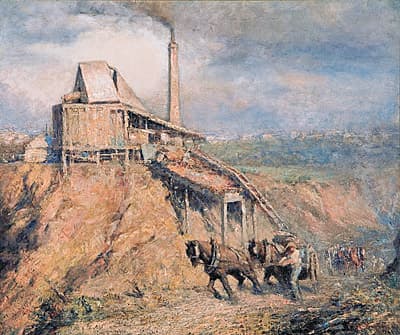Frederick
MCCUBBIN
Australia
1855
–
1917
The old stone crusher (The quarry)
[The stone crusher]
1911
oil on canvas
76.2 (h)
x 91.4 (w)
cm
Art Gallery of South Australia, Adelaide
purchased through the Elder Bequest Fund, 1943
The old stone crusher is one of a series of paintings of quarries produced by McCubbin, including the sketch, The stone crusher (cat 56). Dealing with the themes of noble toil and city industry, the painting shows cart horses and men hauling a heavy load from a crushing mill. The workers are probably carting basalt (bluestone), which was quarried at Burnley up until the 1920s and used for building and road construction throughout Melbourne. The quarries and mill had been established in Burnley as early as the 1860s. In his early works, McCubbin immortalised the spirit of the pioneer, whereas here he observes an everyday activity. The dusty workings of the stone crusher with its smoking chimney stack demonstrate the encroachment of industry into the natural landscape. While the team of working horses is evocative of an earlier era, paradoxically it is their hard work and honest labour which advances the growing metropolis of Melbourne, glimpsed in the background through a soft lavender coloured haze.
When first exhibited in 1911 (if indeed this work was the work referred to), one reviewer admired ‘The Quarry, which pulsates with mellow and subtle color’ (Age, 14 October 1911, p 15); another observed that: ‘“The Quarry”, will arrest attention for its mellowness and simple unswerving fidelity to nature’ (Argus, 13 October 1911, p 4). The old stone crusher was considered one of McCubbin’s best paintings of this period, noted as such in the 1916 monograph on the artist. It was said to be one of four pictures ‘that embody the painter’s lifework’, with each picture ‘in its way, perfect, and each represent[ing] the culmination of patient observation and matured thought’ (MacDonald 1916, pp 78–9).
Writing of The stone crusher in the early 1940s the artist’s son Louis commented that his father:
has departed from the direct method of painting of his earlier works, and glazes or, to use his own works, ‘scumbles’ his colour on by means of many applications. The picture was first ‘sketched in’ in one warm tone, probably with some sienna and white. After this, painting in colour commenced. The pigment was mixed on the palette and applied with a knife. It was kept purer in this way than by mixing it with a brush and, applied thinly, was kept transparent. After each painting the canvas was put in the window or out in the sun until the pigment became bone-dry; it was then rubbed down with a pumice stone until the surface was as smooth as glass. By this method the underneath colours would show through the over-paintings, and the effect of transparency and broken colour was accentuated; advantage could also be taken of ‘accident’. This process was continued until the picture was completed. In some instances it might take several years (Bulletin of the National Gallery of South Australia, vol v, no 1, July 1943).
McCubbin’s quarry paintings pre-empt those of the South Australian artist Hans Heysen, who a decade later would explore the subject of quarries, most notably winning the 1922 Wynne prize for his watercolour, The quarry 1922 (AGNSW). Heysen’s interest however lay in the geological form of the landscape, showing quarry workers dwarfed by their surroundings, whereas McCubbin’s focus is the activity of the crushing mill and the men and horses carting the basalt.
The painting was purchased by the Art Gallery of South Australia in 1943 for 150 guineas from the estate of Annie McCubbin, the artist’s wife, during the directorship of the gallery by the artist’s son, Louis McCubbin.
Rebecca Andrews
